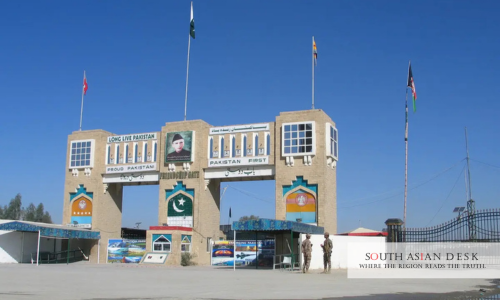Quetta, October 25, 2025 – Pakistani officials upheld the Chaman border closure repatriation on Saturday, permitting Afghan nationals to return with household goods while enforcing a 12-day transit trade halt due to Afghan-side security threats. The Federal Board of Revenue (FBR) reported over 1,000 stranded vehicles at the Chaman and Torkham border crossings. This partial access eases refugee flows but cripples bilateral commerce worth millions in daily turnover.
Border Tensions Strain South Asian Stability
The Chaman border closure and repatriation highlights the deepening fractures in Pakistan-Afghanistan ties, with ripple effects across South Asia’s fragile economies. Pakistan’s $2.5 billion annual trade with Afghanistan supports approximately 500,000 jobs in border regions, including Balochistan and Khyber Pakhtunkhwa. The suspension exacerbates fuel shortages in northern Pakistan and inflates food prices in Kabul, where 70 per cent of wheat imports originate from Pakistani mills. For India and Bangladesh, which rely on Central Asian transit routes, prolonged halts could disrupt $1 billion in overland cargo, fueling inflation and migration pressures. UNHCR data shows 338,975 Afghan returns since April, underscoring a humanitarian crisis that tests regional solidarity amid Taliban governance challenges.
Pakistan Afghanistan Trade Suspension Grips Borders
Authorities have extended the suspension of Pakistan-Afghanistan trade at Chaman since October 15. The measure followed unprovoked Afghan aggression that endangered customs staff, per a government press release. FBR suspended clearances for exports, imports, and transit cargo at five key points: Torkham, Ghulam Khan, Kharlachi, Angoor Adda, and Chaman.
Over 1,000 trucks are now idle at these stations. At Chaman, 412 transit vehicles queue alongside five imports and 25 exports. Torkham holds 83 transit trucks, 255 exports, and 24 imports, with an additional 200 trucks stranded on the Jamrud-Landi Kotal road. These include essentials like fabric, paint, peanuts, and pulses.
FBR cleared 363 pre-closure imports at northern stations to avert market shortages. “Customs staffers are stationed at border points and ready to resume the clearance process as soon as it reopens,” the board stated. Most personnel retreated to headquarters for safety, leaving only a minimal number of inspectors on site.
Exporters refuse to file goods declarations, hoping for a swift resumption of trade. Daily losses mount to PKR 100 million in perishable goods spoilage alone. The Balochistan Chamber of Commerce estimates that the weekly impact on local traders is approximately PKR 500 million.
Transit Trade Halt Due to Chaman Border Closure
The transit trade halt at Chaman paralyses a vital artery for Afghan-bound goods from Pakistan and third countries. Before October 15, Chaman processed 200 trucks daily, facilitating $1 million in fees and duties. Now, 500 transit vehicles wait combined at Chaman and Torkham, loaded with textiles, machinery, and construction materials.
The halt stems from incidents on October 12 at the eastern borders, which extended to Chaman three days later. Afghan forces reportedly fired on Pakistani patrols, prompting the lockdown. No pedestrian or commercial crossings occur except for repatriation.
District officials in Chaman report receiving no directives from Islamabad regarding reopening. “The border has been closed for the last 12 days and not opened for any commercial activities so far, including transit trade,” a senior customs officer said. Traders petition for partial access, citing Istanbul talks between officials as a potential breakthrough.
Broader effects hit supply chains. Kabul markets are facing onion shortages, with prices up 30 percent. In Quetta, warehouses overflow with unsold cement and steel, leaving 10,000 workers idle.
Afghan Refugees Return Chaman Amid Selective Access
Chaman border closure repatriation allows for brief daily openings for Afghan refugees to return to Chaman. Vehicles carrying household items cross unhindered; however, no exact figures are available for October’s flows. UNHCR-IOM tracked 12,329 total returns from Pakistan for the period of October 12-18, down 53 percent from the prior weeks, with 580 deportations.
Since April 1, 338,975 Afghans have been repatriated, including 55,779 via deportation. Fear of arrest drives most voluntary exits, per agency data. Punjab province alone deported 22,000 people in October, many of whom were routed through Chaman.
Returns peaked at 45,473 for the period of September 21-27, primarily via Torkham and Ghulam Khan. Chaman handles 20 percent of the flows, aiding families from Balochistan camps. Each convoy carries 50-100 persons, with IOM providing water and medical aid at crossing points.
Refugees cite Pakistan’s Illegal Foreigners Repatriation Plan, resumed March 7, as the catalyst. The plan targets undocumented Afghans, though exemptions apply for vulnerable groups. “Many leave with heavy hearts, but home calls,” an IOM field officer noted in a flash update.
This selective policy strikes a balance between security and humanitarian needs. Yet, bottlenecks form as trade vehicles block access lanes, delaying family convoys by hours.
Background: Escalating Tensions Fuel Closure
Pakistan-Afghanistan frictions trace to the Taliban takeover in 2021, with accusations of cross-border militancy. Deportations surged after the 2023 plan, repatriating 1.7 million by mid-2025. Border clashes intensified in September, with Torkham shootings killing two guards.
Chaman, a 19th-century gateway, once bustled with 5,000 people crossing daily. Post-closure, it echoes with idle engines and anxious waits. Economic pacts, such as the 2024 Afghanistan-Pakistan Transit Trade Agreement, are now gathering dust, as volumes have plummeted by 100 percent.
The UNHCR warns of winter risks for returnees, with 40 percent lacking shelter in Herat and Kandahar. Pakistan hosts 1.4 million registered Afghans, down from 3 million before the plan.
What’s Next: Diplomacy or Deadlock?
Istanbul meeting outcomes could signal relief. FBR eyes November resumption if aggression ceases. Meanwhile, Chaman border closure repatriation persists, a thin thread of normalcy in a frayed frontier.
In closing, the Chaman border closure and repatriation underscore resilience amid rupture, but a sustained trade revival demands de-escalation to safeguard lives and livelihoods.
Published in SouthAsianDesk, October 25th, 2025
Follow SouthAsianDesk on X, Instagram, and Facebook for insights on business and current affairs from across South Asia.






